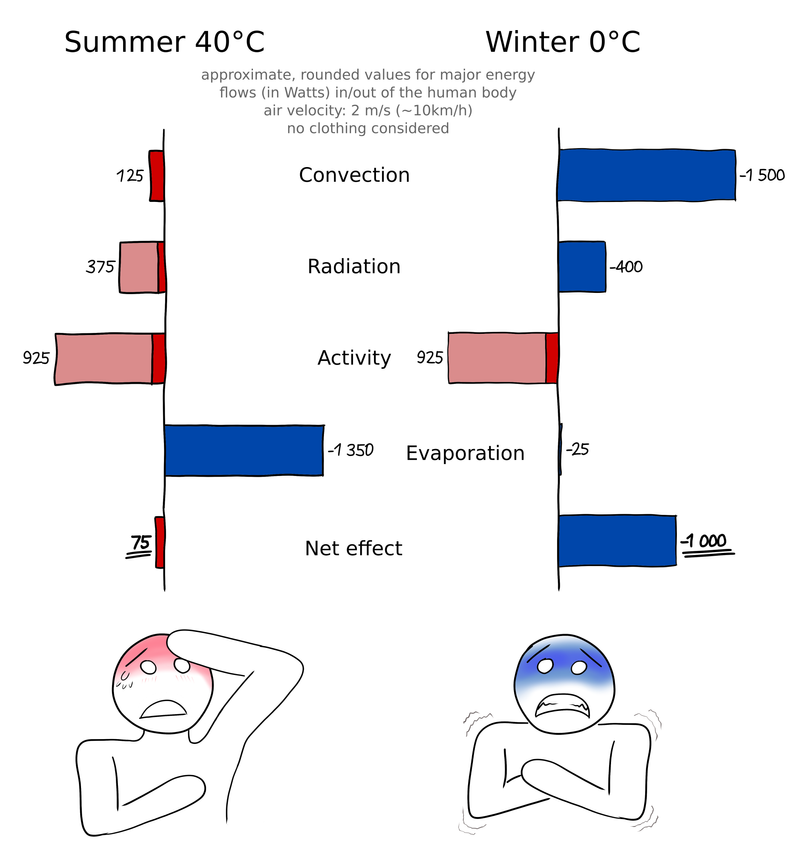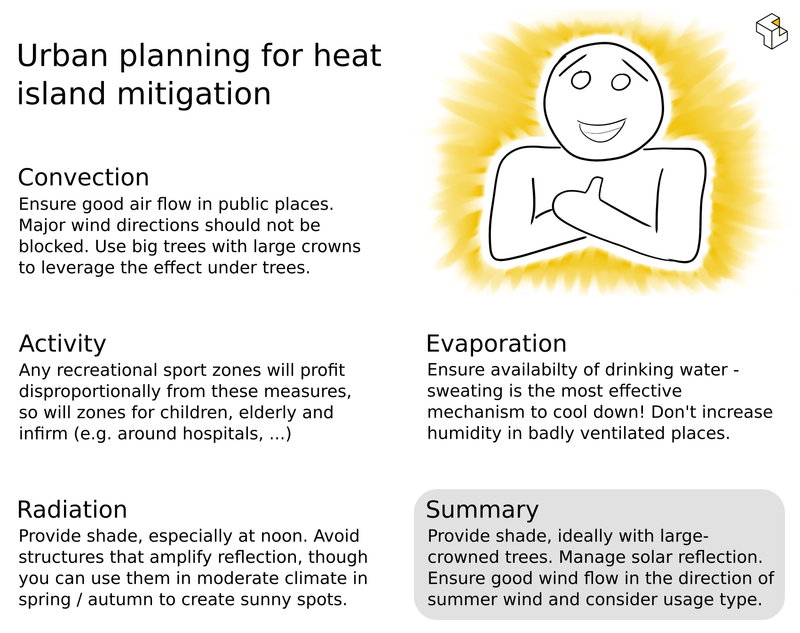Microclimate and human thermoregulation
Summer heat waves are increasingly making the headlines, and scientists are concerned about the short- and long-term effects on health and morbidity. Here, we give a rough overview of how our body keeps its temperature in hot and cold microclimate conditions, and how architects and urban planners could incorporate this into their planning practice to create urban environments that are fit for increasingly hot conditions in cities. Skip down to the summary to get to the most important parts quickly.

To understand how surrounding microclimate conditions work on our health and feeling of comfort, we need to consider 4 major mechanisms of heat transfer1:
- Convection: Heating and cooling by moving air over skin
- Radiation: The net effect of solar radiation on the human body
- Activity: internally generated heat, e.g. when exercising
- Evaporation: Evaporative cooling of the skin by sweating
A basic understanding of these factors2 and their role in hot and cold microclimate conditions will allow us to derive some basic design guidelines for urban planning. To minimize the effect of global warming and urban heat islands on human well-being, it is critical to understand the relative contribution of these factors to human thermoregulation to make informed decisions in urban planning.
Let’s look at the factors in turn, before we arrive at some general guidelines on how to mitigate urban heat islands’ amplification of hot summers. In order to feel most comfortable, the net effect of the energy flows above should be zero on average - the graph above shows unsustainable, extreme thermal situations, resulting in freezing for the winter scenario and heatstroke for the summer scenario.
Convection

Convection is the amount of energy transferred by wind - when it is cold, this is the infamous wind chill effect that can quickly become the biggest factor for freezing. Luckily, wearing thick winter clothing (= insulation) is a readily available countermeasure, which can cut down wind chill to an easily manageable factor.
The nearer the air temperature is to our body temperature, the lower the contribution of convection. Only when the air temperature rises above the skin temperature does convection increase the heat content in our body - anything below that will have a cooling effect (clothing not considered).
Radiation

Radiation can cause both heating or cooling of the body. Long-wave radiation (infrared radiation such as from a fire, which you can feel on your skin) is emitted from the body into the environment when it is cold. Like for convection above, this can easily be inhibited by clothing.
Conversely - and this is one of the primary causes for the urban heat island effect - when surrounding surfaces are above our body temperature, they will radiate energy into our body - this is represented by the dark-red part of the radiation bar in the graph above.
The light-red radiation bar, which is much bigger, represents direct solar radiation (short wave radiation that is transformed into heat when it hits our body). At roughly 300 Watts in summer, it is a major contributor to the energy inflow to the body at this time of year. When not exercising hard, this is actually the biggest heat source. Consequently, shielding from direct sunlight, especially when the sun is high in the sky, will largely remove this source of body heating.
Activity

Internally generated heat has a minimum that is always present. This energy of about 100 Watts is the base metabolic activity (your heart beat, breathing, …) - in the graph, this is represented by the dark-red part. On top of that, there is a bar with a whopping 800 Watts as a maximum of energy output from work or exercise. This maximum can only be sustained by trained individuals over short time periods; however, in our example, the cooling from sweating (see below) is also at a maximum. For the average person, these values will be significantly lower for sustained activity.
Of course, this internal source of heat is present in summer and in winter. This amount of heat always needs to be balanced by some sort of heat sink. This is relatively easy in cold conditions, but can quickly become a problem when it gets hot.
In the planning process, it is therefore important to consider the expected activity in an area. People waiting for a bus or sitting in an outdoor cafe will have different amounts of internal heat that need to be managed, and the same is true for people walking around or exercising in an athletic field. Also, the duration of the activity plays a role - crossing a hot, sunny courtyard is a much different experience than having to wait in the same place for half an hour.
Evaporation

Lastly, the biggest heat-sink and the human body’s superweapon to prevent overheating: evaporation from sweating. If our surroundings approach the same temperature as our body, there are no external means of cooling available anymore. Therefore, the only way to cool down is to use the large heat of evaporation of water. This fact is also what gets health officials and scientists worried: the combined effect of global warming, urban heat islands and increasing urban population means that there are more and more people exposed to microclimatic conditions that make it hard (or sometimes impossible) for them to cool down.
While insulation is a low-tech, readily available solution to counter freezing in winter, there are not many personal options available to cool down when it is hot. The cooling demand that is not managed by urban design will have to be covered by energy-intense climatization, which in turn is a source for both global warming and the urban heat island, as we discuss in our article about climate-conscious architecture.
The 1350 Watts of cooling power shown in the graph is the maximum achievable cooling from evaporating 2 liters of water per hour. This is not far from the maximum achievable cooling for humans, and sets an upper limit for the hot conditions that humans can survive sustainably.
It is important to note that evaporation can only occur until the surrounding air is saturated, i.e. 100% relative humidity is reached. The more humid a place is, the less evaporative cooling is possible. At a relative humidity of 100%, there is no evaporative cooling possible anymore, and the most powerful heat sink mechanism of the human body will fail. It is therefore important to prevent any substantial increase in humidity from urban planning.
Summary and relevance for urban planning

Keeping cities liveable and comfortable for their citizens in the light of ever hotter microclimate poses a challenge to urban planning, but there are plenty of levers that planners and real estate developers can operate to influence the situation and create pleasant places.
Providing shade and ensuring well-ventilated spaces are the two biggest factors that influence microclimate in hot conditions. Deciduous trees are a good example: not only do they provide shade in summer (while permitting sun in spring and autumn), they also force air to flow around their large crowns, resulting in higher air velocities underneath, were people can enjoy shade and a cool breeze in summer.
However, the planning process needs to take details into account: a tree in a courtyard that is not ventilated enough might have a detrimental effect on the microclimate by raising the local humidity, which inhibits evaporative cooling. We provide a more focused example for this in our article about courtyard greening.
Staying with our example, evapotranspiration of trees also leads to a direct reduction of air temperature, but this will mainly influence convection, which is far from the largest energy flow and will quickly dissipate as air moves. Direct air cooling by evapotranspiration is an appreciable effect, but not the largest. Conversely, larger areas like parks or networks of streets with many trees will definitely show a combined effect from evaporative cooling by plants.
With all these possibilities - air flow, radiation, evaporative cooling - it is important to factor in the intended use of the zone. Recreational sport areas have much different requirements than, for example, outdoor dining or calm-zones around hospitals.
We are happy to talk about your particular needs, be it in large-scale urban development or single real-estate projects. Just let us know about your project and we’ll get back to you!
Digging deeper…
The aim of this article was to give a high-level overview of the major influencing factors of human thermoregulation in the context of urban planning. As such, we left out many details and dependencies in our little calculation. You can download a calculation sheet of our simple human thermoregulation model to take a look at the assumptions we made. For example, we did not consider the effect of humidity, which influences both evaporative cooling as well as convection. We also did not factor in human behavior - our model human is not wearing any clothing for the sake of the calculation (even though we did make assumptions about the skin area that is exposed to solar radiation).
Another critical issue is how to represent this information in the context of architecture and urban planning. Very complex models like PET are accurate for their consideration of a plethora of details (down to the footwear type, body weight and minutes spent in a certain spot), but are very hard to interpret correctly, if these details are not carefully selected. Very simple representations, on the other hand, use wind at a height of 10 meters, or completely omit solar radiation. In our daily work, we strive to find the sweet spot between these extremes.
For further reading, we recommend articles about humidity and human health, like for example this Science Advances article titled The emergence of heat and humidity too severe for human tolerance or, from a recently published book, this chapter titled Climate Change and Human Health.
There is a fifth mechanism, conduction, but it is negligible for our discussion. ↩
For those who want to dig deeper and play around with the numbers, we provide this basic calculation sheet for human thermoregulation. ↩
Published: